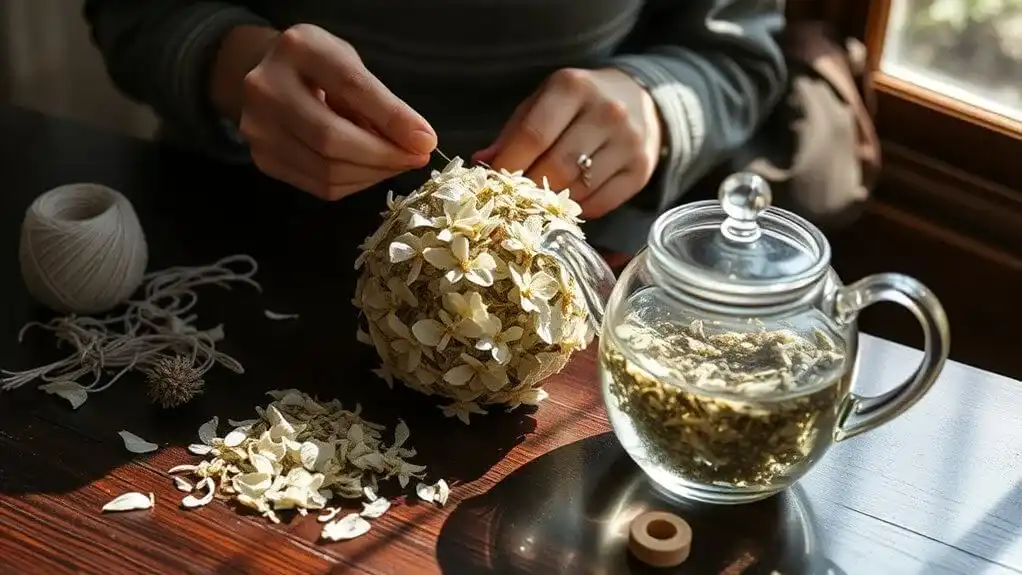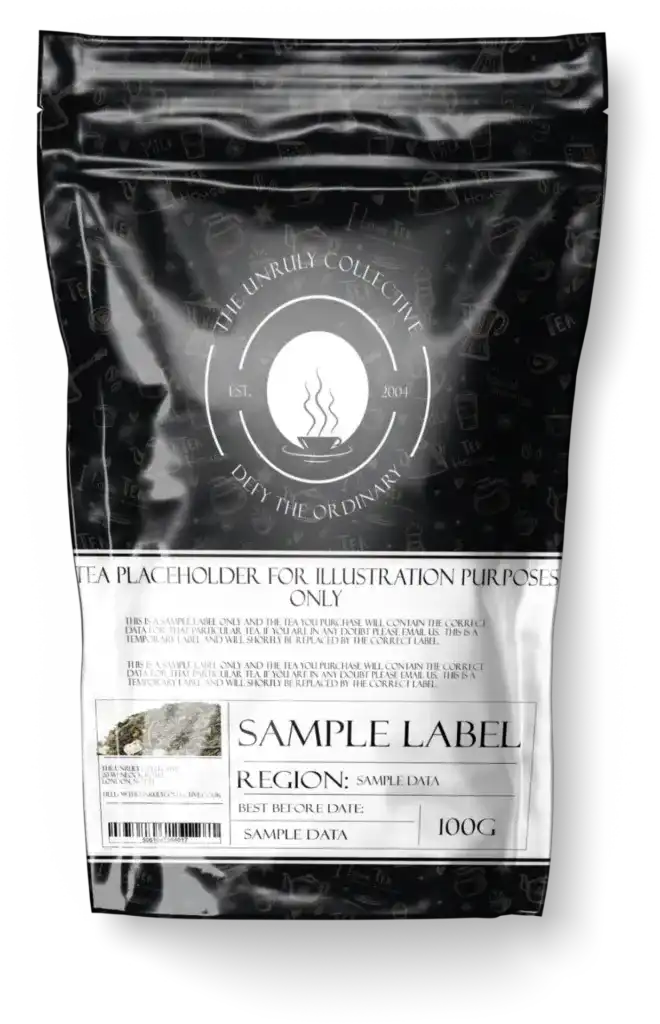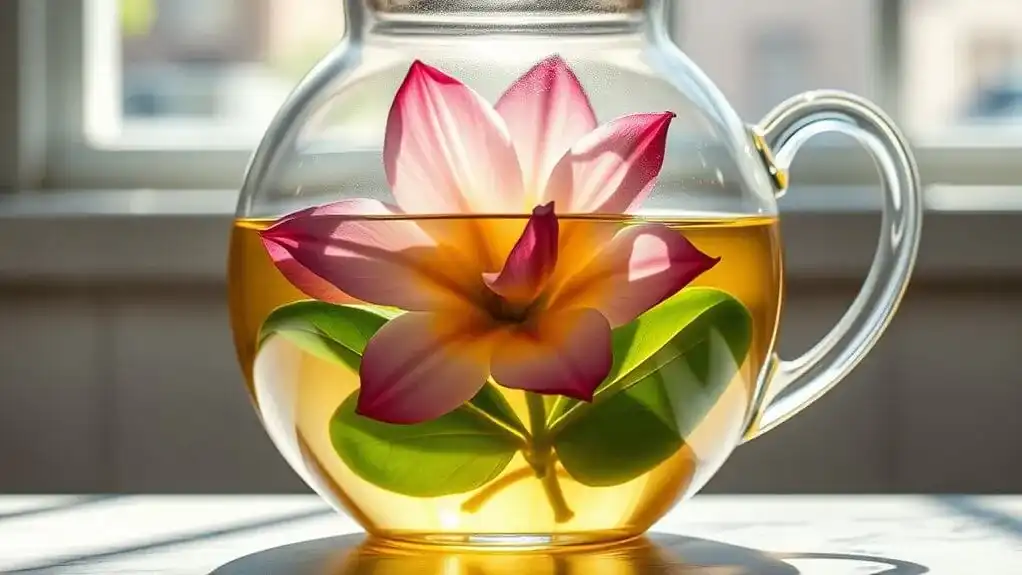Artisans craft flowering teas through a meticulous process that combines premium Silver Needles green tea leaves with carefully selected edible flowers. They moisten and shape approximately 20 tea leaves around dehydrated blooms, securing them with natural cotton strings. Each 6-8 gram bundle undergoes precise drying at 95°F for up to 30 hours before storage in airtight containers. This ancient Chinese art form transforms simple ingredients into stunning displays that reveal their magic with every steep.
Key Points
- Artisans carefully select premium green tea leaves and pesticide-free flowers, focusing on Silver Needles Green Tea as the primary base.
- Tea leaves are moistened with damp cloths for flexibility, then bundled with approximately 20 long silver needle leaves.
- Dehydrated flowers are strategically placed within the tea bundle, which is secured using natural white cotton strings.
- Various sewing techniques create intricate designs, with artisans shaping bundles around cotton balls for consistent quality.
- The completed tea bundles undergo careful drying for 28-30 hours at 95°F to preserve shape and extend shelf life.
The Art and Heritage of Flowering Tea
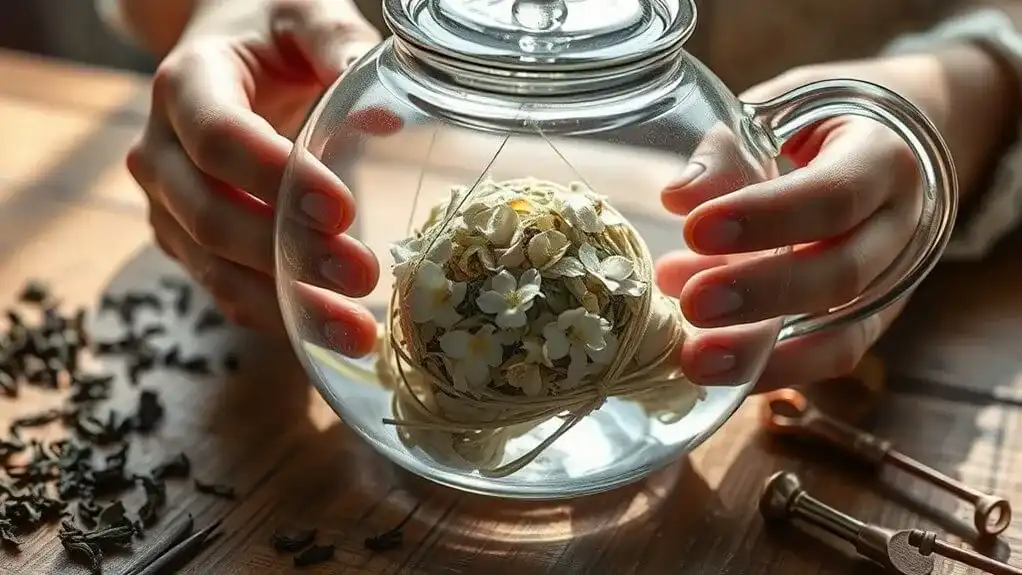
While many traditional tea practices have evolved over centuries, flowering tea's artistic journey traces back to China's Tang Dynasty, where it emerged as both a visual spectacle and cultural symbol. The historical origins of this art form reflect a deep connection to Chinese culture, where it has long been cherished at weddings and formal gatherings. Green and white tea leaves are commonly used as the base for these creations. Professional artisans dedicate countless hours to their craft, with skilled workers capable of producing 2.5 kilograms of flowering tea per day.
The cultural significance of flowering tea extends beyond its visual appeal, symbolizing harmony, eternal love, and longevity in Chinese traditions. Though initially crafted for aesthetic purposes rather than consumption, the practice gained prominence as a gesture of respect and gratitude. In the 1980s, tea artisans revolutionized the craft with innovative folding techniques, helping spread its popularity globally. Today, the practice continues to honor its heritage while adapting to modern tastes and preferences. Modern artisans create these intricate designs by handcrafting and sewing delicate tea leaves and flower petals together to achieve their stunning appearance.
Essential Materials and Ingredients
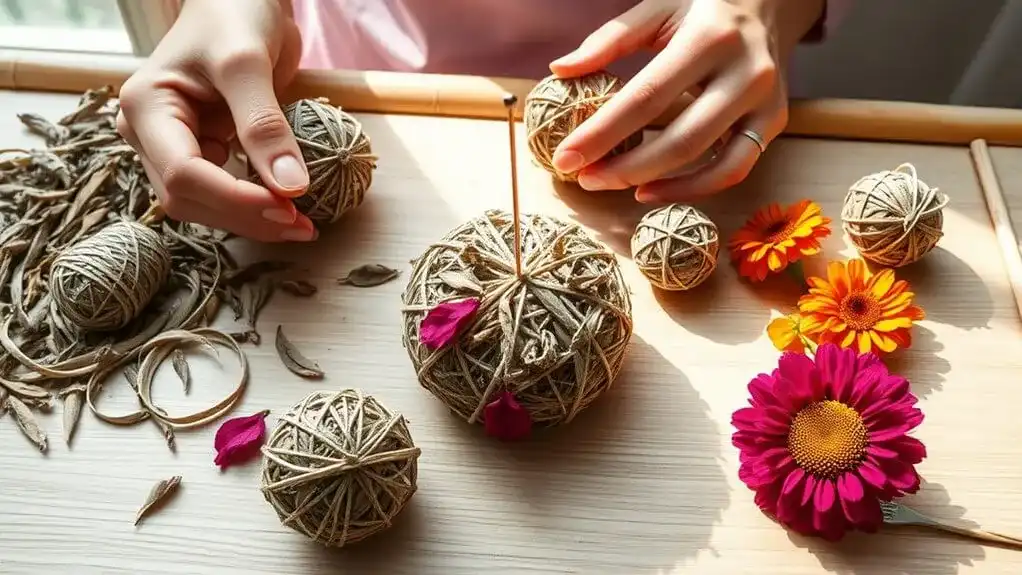
Creating flowering tea requires carefully selected premium ingredients and specialized materials. High-quality tea leaves, particularly Silver Needles Green Tea, serve as the foundation for these artisanal creations. Artisans select from various flower varieties, including jasmine, lily, osmanthus, hibiscus, and marigold, each chosen for their distinct flavor profiles and visual appeal. The ancient tea tradition lives on through skilled artisans who hand-tie each bundle with precision and care. Pesticide-free flowers are essential for ensuring the safety and purity of these artistic tea creations. The unique process emerged into greater prominence during the 1980s artisan revival.
The tea's preparation demands meticulously processed tea buds that undergo traditional green tea production methods. These buds are carefully moistened and shaped before being combined with naturally dehydrated edible flowers. The flowers themselves must be harvested at peak condition and properly dried to maintain their integrity. Through precise bundling and sewing techniques, artisans create compact tea parcels weighing between 6 to 10 grams, with strategic spacing to allow for the dramatic blooming effect when steeped.
The Delicate Preparation Process

As artisans commence on the intricate preparation of flowering teas, each step demands precision and patience. The process begins with carefully selected tea leaves, typically green or white varietals, which are gently moistened to guarantee flexibility during shaping. This vital step enables proper flavor infusion while maintaining the tea's integrity. Expert artisans utilize cotton thread sewing to bind the components together securely.
The artisan then meticulously wraps the tea leaves and chosen flowers around a small core, creating a compact ball that will later transform into an aesthetic presentation. Clear glass vessels allow enthusiasts to witness the visual performance of these remarkable creations. The final and most essential phase involves drying the tea ball thoroughly. This step not only preserves the carefully crafted shape but also locks in the delicate flavors and extends the tea's shelf life. The result is a perfectly balanced tea ball that's ready to unfurl its beauty when steeped. When prepared correctly with water at 180°F, these carefully crafted blooms will release their optimal flavors and visual display.
Hand-Binding and Sewing Techniques
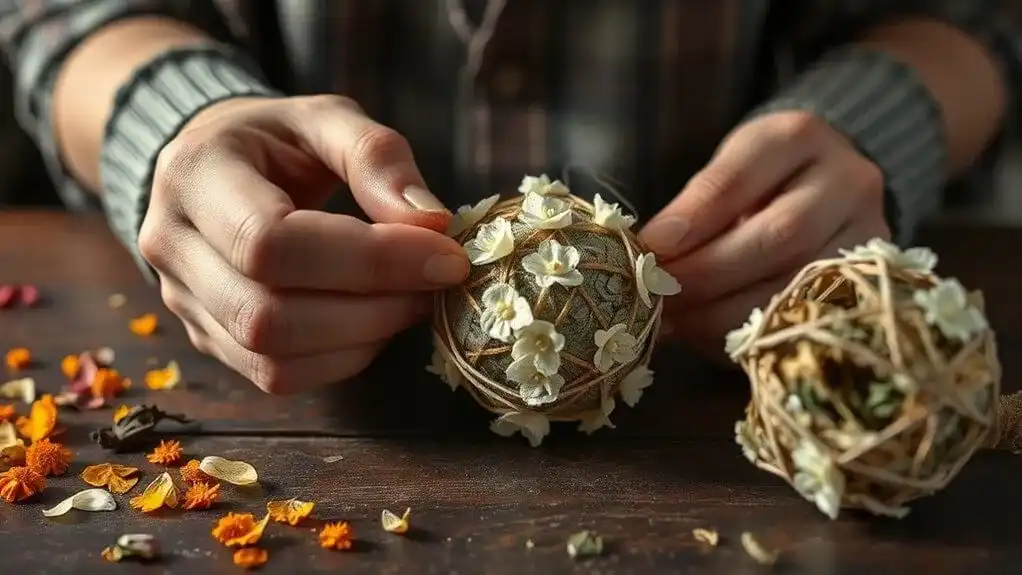
The meticulous hand-binding process lies at the heart of flowering tea craftsmanship. Tea masters begin by gathering approximately 20 long silver needle leaves, carefully moistening them to guarantee flexibility. The binding methods start at the base, where artisans secure the leaves together using natural white cotton strings. High-quality green tea remains essential for authentic results. The sewing precision becomes vital as dehydrated flowers are placed in the bundle's center. Each teaball requires 6 to 8 grams of materials to achieve the proper size and shape. Masters then wrap the tea leaves around the flowers, creating a protective cocoon before sewing the top portion. Each bundle is meticulously wound with thread to maintain its shape and wrapped in cloth for the final drying phase. This careful attention to detail guarantees that when steeped, these hand-sewn creations will unfurl gracefully, revealing their hidden floral treasures and offering multiple steeping opportunities.
The Magic of Drying and Preservation
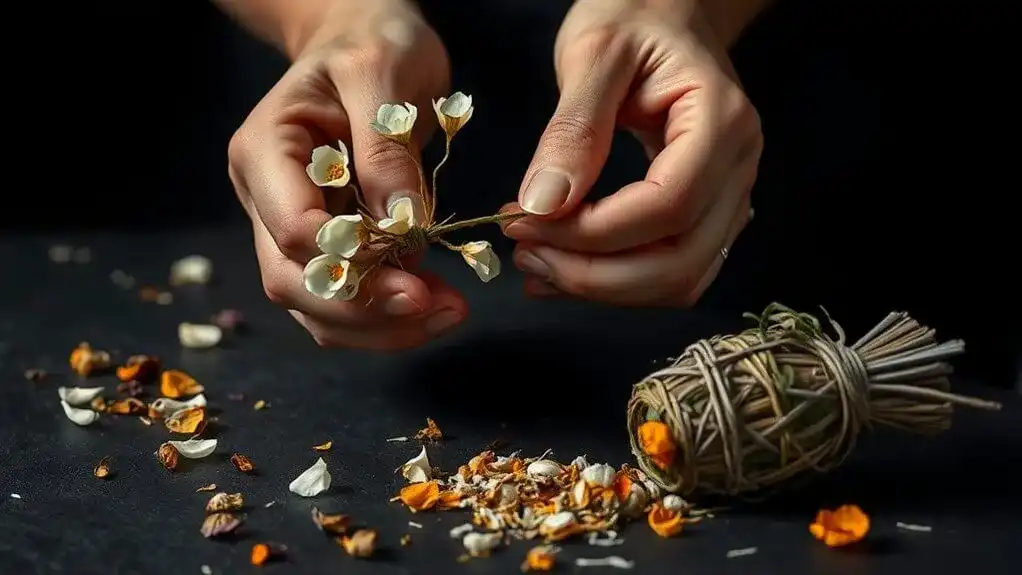
Proper drying and preservation techniques transform delicate flowering teas into long-lasting works of art. Artisans employ several drying techniques, with dehydrators proving most efficient for commercial production. While air drying takes 3-5 days and collects dust, dehydrators complete the process in 28-30 hours at 95 degrees F, preserving the blooms' integrity. Amber mason jars offer optimal protection when storing dried herbs and flowering teas for extended shelf life. Originating in the royal Chinese courts, these artful teas were initially crafted purely for visual enjoyment before becoming prized for consumption. German chamomile varieties are particularly valued for their potent essential oils and medicinal properties.
Once dried, preservation methods become vital for maintaining quality. Tea masters store their creations in airtight metal or ceramic containers, protecting them from light exposure that can degrade flavor compounds and catechins. They're particularly mindful of humidity control, as moisture accelerates oxidation and causes staleness. Even in ideal conditions, most flowering teas gradually lose their distinct characteristics over time, making proper storage essential for extending their artistic and aromatic lifespan.
From Tea Ball to Blooming Display
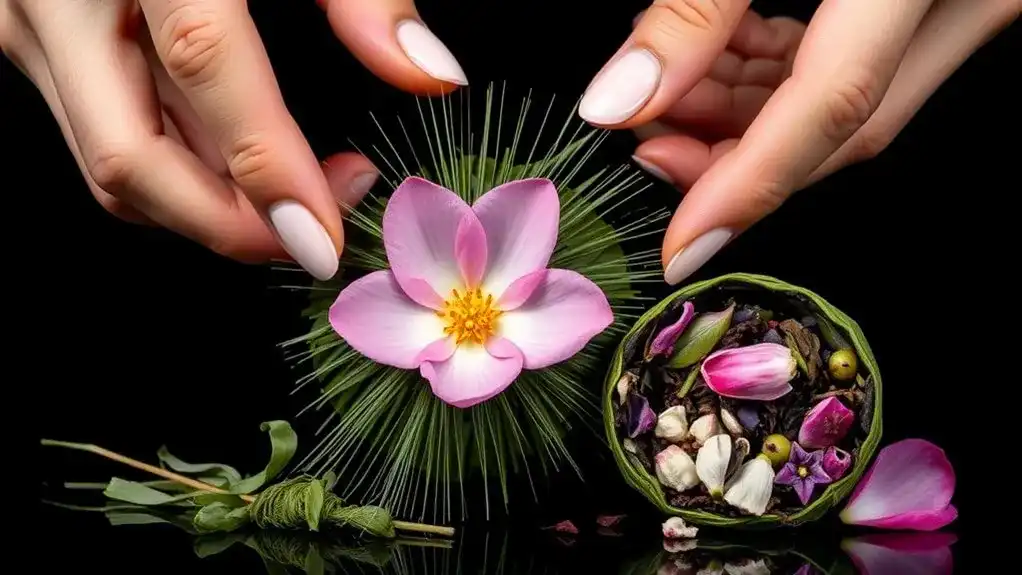
Creating a flowering tea ball requires three essential components: premium tea buds, carefully selected edible flowers, and expert binding techniques. Skilled artisans carefully position flowers in the center of each bundle while wrapping tea leaves around them, ensuring proper spacing for ideal blooming aesthetics. This meticulous process reflects the rich heritage of Fujian Province, where these artistic teas first originated.
The tea infusion process begins when hot water meets these handcrafted spheres. Each ball, weighing between 6 to 10 grams, is meticulously sewn using natural white cotton strings. Artisans create tiny spaces between the petals and tea buds, allowing the bundle to expand gracefully during steeping. The final product undergoes careful drying and inspection before being individually packaged to maintain freshness. When brewed, these intricate bundles transform into stunning displays that can be preserved in the refrigerator for up to 48 hours after use.
The Skilled Craftsmanship Behind Each Creation
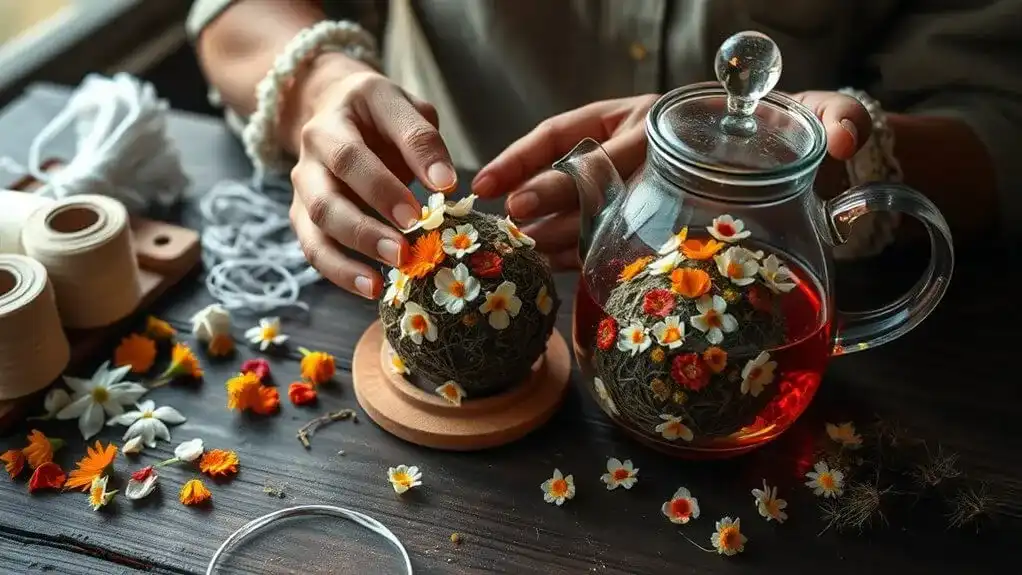
Behind every flowering tea ball lies a meticulous process that combines traditional handicraft with modern precision. Skilled artisans carefully select premium green tea leaves and edible flowers, preparing them by covering them with damp cloths to achieve the ideal malleability for sewing. Drawing from their centuries-old heritage, these techniques have been passed down through generations of tea artisans in Yunnan.
The artisan techniques involve precise measurements, with each ball requiring 6-8g of materials. Using natural cotton strings, craftsmen employ various sewing methods to create intricate designs, ensuring proper spacing between petals and tea buds for optimal blooming. They then shape the bundles around cotton balls and carefully dry them to lock in both form and flavor.
It's a time-intensive craft, with even experienced artisans producing only 2.5 kg daily. Each piece reflects the perfect balance of artistic vision and technical expertise needed to create these blooming masterpieces.
Conclusion
Creating flowering tea takes more than meets the eye, requiring skilled artisans who've spent years perfecting their craft. While each blooming tea ball represents hours of meticulous work binding flowers and leaves together, the end result makes it all worthwhile. As these botanical marvels unfold in hot water, they're bringing ancient traditions to modern tea lovers and proving that patience bears the sweetest fruit.
